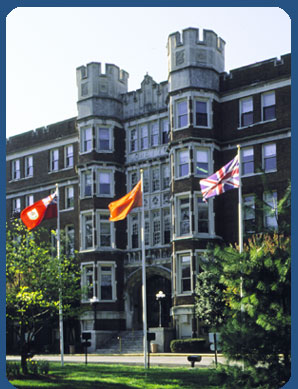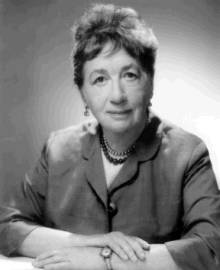| Women's Intellectual Contributions to the Study of Mind and Society Students, as part of an advanced seminar, examined and wrote about the lives of these women,
their intellectual contributions, and the unique impact and special problems that being female had
on their careers. |  |
| For information about referencing this paper - Click Here |
Hortense Powdermaker |  |
Family Life
Hortense Powdermaker was born on December 24, 1900 in Philadelphia, PA. She came from a German Jewish business family. Hortense was one of four children and was not the only one to go into the behavioral and social sciences, her sister was also a well-known psychoanalyst. While reflecting on her childhood in her later years, "Powdermaker felt detached from and critical of what she considered the familyπs materialistic values and sterile culture." (Gacs 291)
Powdermaker never married in her life and never had any children. Silverman described her life as one in which, "[she] was a sociable, deeply humane person, with a wide circle of friends outside of anthropology as well as within the field." Silverman also discusses that although Hortense never married she did have romantic involvements with men and although she never had children of her own she was able to become a foster mother to Won Mo Kim, a young Korean violinist.
Education
After graduating from Western High School Powdermaker went on to attend Goucher College majoring in history. She graduated in 1921 with her BA and began to work for the Amalgamated clothing workers, after becoming interested in the labor movement during college. Powdermaker began to find dissatisfaction working at a desk job and asked to be moved onto a new position. She was put in charge of organizing workers and thus began to gain useful experience in fieldwork. (Wolf)
Powdermaker continued to work for the labor movement for a few years, but began to feel the monotony of the work. She decided to attend the London School of Economics and Political Science. While attending she took a class in social anthropology and was quoted as saying, "anthropology was what I had been looking for without knowing it." In 1925, she began to work under Bronislaw Malinowski with a small group of students and began her work in anthropology. Influenced by Malinowski Powdermaker completed her classes and received her Ph. D. in 1928. (Silverman)
Work
After receiving her Ph. D.. Powdermaker found difficulty in finding funding for her research, she found that although Malinowski was supportive of her during her schooling, like most people of the time he was quite reluctant to support her in finding research projects. Hortense was able to obtain a small grant through the Australian National Research Council to study the small village of Lesu, which was on an island known as the New Ireland off of Papa New Guinea. She then wrote a book, in 1933, based on her experiences and ethnographic observations she was able to make on the island. After returning to the United States Powdermaker was able to obtain a fellowship from the National Research Council to write about her work as well as an affiliation with the Institute of Human Relations at Yale (Silverman).
While at Yale Hortense Powdermaker was introduced to Edward Sapir, who was able to introducing and reinforcing her interests in psychology. Based on her interests at the time Powdermaker decided to do some research in the Deep South. She traveled to Indianola, MI with a fellowship from the Social Science Research Council. She concentrated studying the antagonisms between whites and blacks within a community that was evenly split between the demographics. Her research can now be considered one of the first anthropological studies of modern culture and community. Her second book, After Freedom, was based on her experiences in Mississippi and was completed in 1939. (Wolf)
In 1938. Hortense Powdermaker went on to teach at the newly formed Queens College. There she gained popularity as a teacher and was the founder of the Department of Anthropology at the school. As World War II began Powdermaker also taught at Yale University and wrote quite a few articles as well as a high school text on prejudice. (Silverman).
Hortense Powdermaker's next big project is known as the Hollywood studies. Here Powdermaker proposed that in Hollywood the movies that are made are greatly influenced from the environment in which they are written. She carried out this study by interviewing those who are involved within the movie making process. After completing this study she wrote her most well known book outside of the anthropology world, which she titled, Hollywood, the Dream Factory. This book was met with a lot of criticism, and even Powdermaker, herself, began to look at it in a negative light telling others that she had brought in too many of her own biases during the study which had affected the objectivity of the study. Despite her own criticism, the book is still one of the only studies that takes a look into the world of Hollywood. (Wolf)
Powdermaker's last large study took place in Northern Rhodesia, in which she once again used interviews and surveys to give the best information that she was able to find. This book she labeled Copper Town and discussed the influences of cultural change along with individual change. And in her last book Stranger and Friend Powdermaker discussed all of her major works comparing and contrasting each in relation with the others despite the great differences that each study held. Hortense Powdermaker taught at Queens College up until 1968 when she finally retired in Berkley, CA where she died just two years later in 1970 at the age of seventy-three.(Wolf)
Accomplishments
Hortense Powdermaker was able to accomplish a lot in her life despite being alive in a time where it was not always looked upon as a positive thing to be a women in the working world. Despite the difficulties she had to face she was able to be appreciated by the following honors she was awarded during her lifetime(Wolf):
- Presidency of the American Ethnological Society
- Honorary Doctorate from Goucher College
- Distinguished Teacher Award from the Alumni Association of Queens College
Bibliography
Back to Women's Page